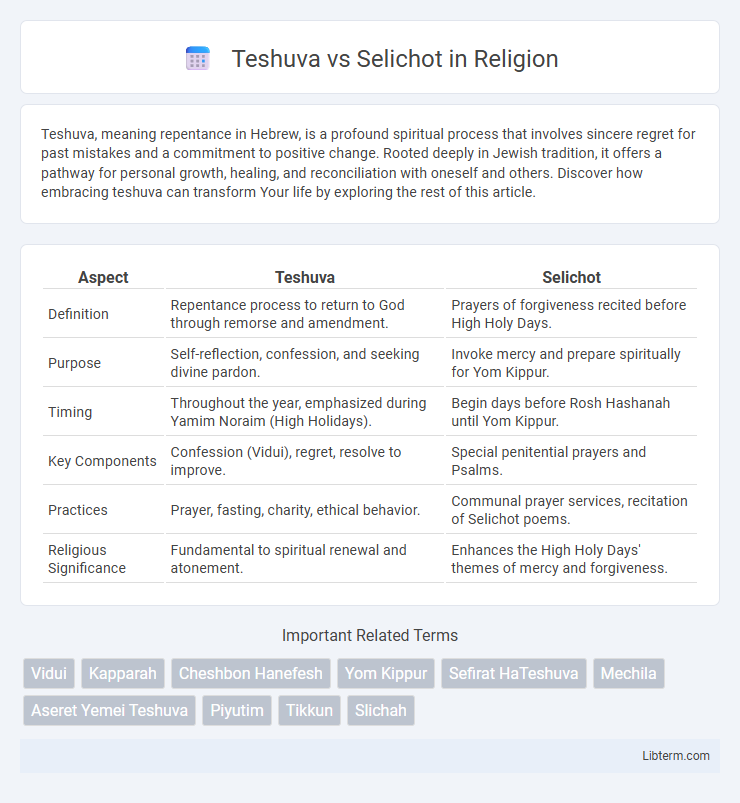Teshuva, meaning repentance in Hebrew, is a profound spiritual process that involves sincere regret for past mistakes and a commitment to positive change. Rooted deeply in Jewish tradition, it offers a pathway for personal growth, healing, and reconciliation with oneself and others. Discover how embracing teshuva can transform Your life by exploring the rest of this article.
Table of Comparison
| Aspect | Teshuva | Selichot |
|---|---|---|
| Definition | Repentance process to return to God through remorse and amendment. | Prayers of forgiveness recited before High Holy Days. |
| Purpose | Self-reflection, confession, and seeking divine pardon. | Invoke mercy and prepare spiritually for Yom Kippur. |
| Timing | Throughout the year, emphasized during Yamim Noraim (High Holidays). | Begin days before Rosh Hashanah until Yom Kippur. |
| Key Components | Confession (Vidui), regret, resolve to improve. | Special penitential prayers and Psalms. |
| Practices | Prayer, fasting, charity, ethical behavior. | Communal prayer services, recitation of Selichot poems. |
| Religious Significance | Fundamental to spiritual renewal and atonement. | Enhances the High Holy Days' themes of mercy and forgiveness. |
Understanding Teshuva: The Essence of Jewish Repentance
Teshuva represents the core of Jewish repentance, emphasizing sincere regret, confession, and commitment to change one's behavior to realign with Torah values. Selichot are special penitential prayers recited during the High Holiday season, serving as a spiritual preparation that invokes divine mercy and introspection. Together, Teshuva and Selichot facilitate a transformative process, enabling individuals to attain forgiveness and spiritual renewal.
Defining Selichot: The Role of Penitential Prayers
Selichot are a series of penitential prayers recited in the days leading up to the High Holidays, specifically designed to invoke divine mercy and forgiveness. These prayers emphasize themes of repentance, humility, and compassion, serving as a spiritual preparation for Teshuva, the overarching process of sincere return to God. Selichot play a critical role by inspiring introspection and encouraging individuals to seek forgiveness before Yom Kippur, the Day of Atonement.
Historical Origins: Teshuva and Selichot in Jewish Tradition
Teshuva, rooted in the biblical commandment of repentance, traces back to the prophetic era emphasizing personal return to God and moral accountability, while Selichot originated in the medieval period as poetic penitential prayers initiated by Spanish Jewish communities. The Selichot prayers incorporate specific liturgical poems (piyyutim) designed to invoke divine mercy during the Ten Days of Repentance, highlighting a communal aspect not as explicitly present in the individualized teshuva process. Historically, Teshuva represents an enduring spiritual mechanism for ethical rectification, whereas Selichot rituals evolved to structure and intensify public worship during the High Holy Days season.
Key Differences: Teshuva vs Selichot Explained
Teshuva and Selichot are distinct yet complementary components of Jewish repentance, with Teshuva emphasizing personal introspection, regret, and commitment to change, while Selichot are communal penitential prayers recited to seek divine forgiveness. Teshuva centers on internal spiritual transformation and ethical behavior, often practiced privately throughout the year but intensifying during the High Holy Days. Selichot, typically recited in the days leading up to Rosh Hashanah, function as liturgical expressions of remorse, invoking God's mercy through structured prayers and poetic supplications.
Spiritual Significance: Inner Transformation vs Communal Prayers
Teshuva embodies a profound process of inner transformation, emphasizing personal repentance, self-reflection, and a heartfelt return to ethical and spiritual alignment with God. Selichot, on the other hand, consists of communal prayers and supplications recited collectively to invoke divine mercy and forgiveness during the High Holy Days. Together, these practices balance individual spiritual renewal with the power of communal solidarity in seeking atonement and divine compassion.
The Timing: When is Teshuva Practiced vs Selichot Recited?
Teshuva, the process of repentance and spiritual return, is primarily practiced throughout the Ten Days of Repentance starting from Rosh Hashanah until Yom Kippur, with heightened focus on introspection and atonement. Selichot, a series of penitential prayers, are recited during the early mornings of the Selichot period, beginning late at night preceding Rosh Hashanah in Ashkenazi tradition or from the start of Elul in Sephardic custom. The timing difference highlights Teshuva as an ongoing internal repentance, while Selichot serves as a formal communal plea for forgiveness at specific designated times.
Rituals and Customs: How Jews Observe Teshuva and Selichot
Teshuva involves a deep, introspective process of repentance where Jews engage in prayer, confession, and sincere commitment to change, often accompanied by fasting and attending synagogue services during the Ten Days of Repentance. Selichot are special penitential prayers recited in the early mornings before Rosh Hashanah and throughout the Ten Days, featuring poetic liturgy and supplications to seek divine forgiveness. The customs emphasize communal participation, with Selichot services often beginning on Saturday night and including heartfelt recitations to inspire personal reflection and spiritual cleansing as part of the Teshuva journey.
Scriptural Sources: Biblical and Rabbinic Foundations
Teshuva, rooted in biblical commandments such as "Return to Me" (Jeremiah 3:12) and "Repent, and turn from all your transgressions" (Ezekiel 18:30), emphasizes personal repentance and spiritual return to God. Selichot prayers, developed in the rabbinic period, draw from Talmudic teachings in tractates Rosh Hashanah and Yoma, framing communal appeals for divine forgiveness during the High Holy Days. These scriptural and rabbinic sources collectively shape the theological foundation for repentance practices in Jewish tradition.
Emotional Dimensions: Personal Reflection vs Collective Supplication
Teshuva emphasizes deep personal reflection and emotional introspection, allowing individuals to confront their own shortcomings and seek internal transformation. Selichot, performed communally, fosters a shared emotional experience where collective supplication and repentance create a unified spiritual atmosphere. This contrast highlights Teshuva as an intimate, self-driven process, whereas Selichot embodies communal emotional solidarity and pleading.
Integrating Teshuva and Selichot: Achieving Holistic Repentance
Integrating Teshuva and Selichot fosters a comprehensive approach to repentance by combining personal introspection with communal prayer. Teshuva emphasizes sincere self-reflection, remorse, and commitment to change, while Selichot prayers invoke divine mercy through structured liturgy and supplication. This fusion enhances spiritual transformation, aligning heartfelt repentance with collective seeking of forgiveness for holistic atonement.
Teshuva Infographic

 libterm.com
libterm.com